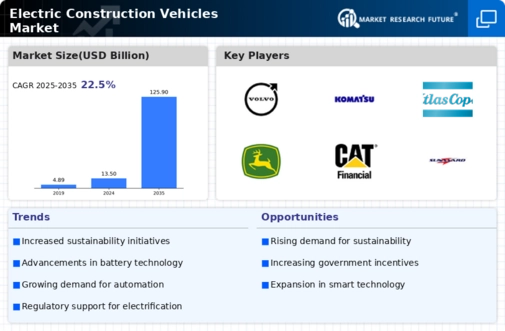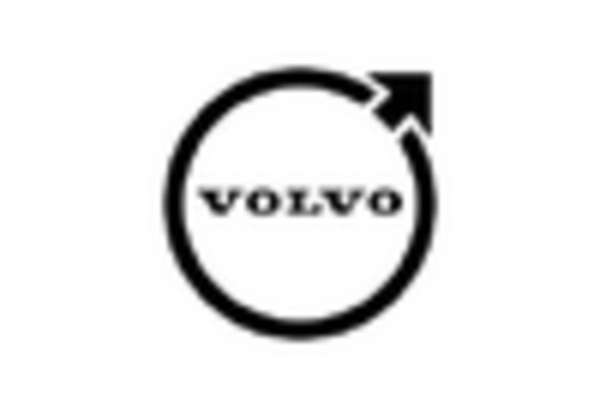-
EXECUTIVE SUMMARY
-
MARKET INTRODUCTION
-
2.1.
-
Definition
-
Scope of the Study
- Research Objective
- Limitations
-
2.2.2.
-
Assumptions
-
RESEARCH METHODOLOGY
-
Overview
-
Data Mining
-
Secondary Research
-
Primary Research
- Breakdown of Primary
-
3.4.1.
-
Primary Interviews and Information Gathering Process
-
Respondents
-
Forecasting Model
-
Market Size Estimation
- Top-Down Approach
-
3.6.1.
-
Bottom-Up Approach
-
Data Triangulation
-
Validation
-
MARKET DYNAMICS
-
Overview
-
Drivers
-
Restraints
-
Opportunities
-
MARKET FACTOR ANALYSIS
-
5.1.
-
Value Chain Analysis
-
Porter’s Five Forces Analysis
- Bargaining
- Bargaining Power of Buyers
- Threat of
- Threat of Substitutes
- Intensity of Rivalry
-
Power of Suppliers
-
New Entrants
-
COVID-19 Impact Analysis
- Market Impact Analysis
- Regional
- Opportunity and Threat Analysis
-
Impact
-
ELECTRIC CONSTRUCTION
-
VEHICLES MARKET, BY TYPE
-
Overview
-
Hybrid
-
Pure-Electric
-
Dual-Frequency
-
ELECTRIC CONSTRUCTION VEHICLES MARKET, BY PROPULSION
-
TYPE
-
Overview
-
Battery Electric Vehicle
-
Plug-in Electric
-
Vehicle
-
Fuel Cell Electric Vehicle
-
Hybrid Electric Vehicle
-
ELECTRIC CONSTRUCTION VEHICLES MARKET, BY CHARGING TYPE
-
Overview
-
Normal Charging
-
Fast Charging
-
ELECTRIC CONSTRUCTION VEHICLES
-
MARKET, BY REGION
-
Overview
-
North America
- US
-
9.1.2.
-
Canada
-
Europe
- Germany
- France
- UK
- Italy
- Spain
- Rest of Europe
-
Asia-Pacific
- China
- India
- Japan
- South Korea
- Rest of Asia-Pacific
-
9.3.5.
-
Australia
-
Rest of the World
- Africa
- Latin America
-
9.4.1.
-
Middle East
-
COMPETITIVE LANDSCAPE
-
Overview
-
Competitive Analysis
-
Market Share Analysis
-
Major Growth Strategy in the Electric construction vehicles Market,
-
10.5.
-
Competitive Benchmarking
-
Leading Players in Terms of Number of Developments
-
in the Electric construction vehicles Market,
-
Key developments and Growth
- New Product Launch/Service Deployment
- Merger
- Joint Ventures
-
Strategies
-
& Acquisitions
-
Major Players Financial
- Sales & Operating Income, 2022
- Major Players
-
Matrix
-
R&D Expenditure. 2022
-
COMPANY PROFILES
-
Volvo
- Financial Overview
- Products Offered
- Key Developments
- SWOT Analysis
- Key Strategies
-
11.1.1.
-
Company Overview
-
Komatsu
- Company Overview
- Financial Overview
- Products Offered
- Key Developments
- SWOT Analysis
- Key Strategies
-
Atlas Copco
- Company Overview
- Financial Overview
- Products Offered
- Key Developments
- SWOT Analysis
- Key Strategies
-
John Deere
- Financial Overview
- Products Offered
- Key Developments
- SWOT Analysis
- Key Strategies
-
11.4.1.
-
Company Overview
-
Merlo J C Bamford Excavators Ltd.
- Company Overview
- Products Offered
- Key Developments
- SWOT Analysis
- Key Strategies
-
11.5.2.
-
Financial Overview
-
Caterpillar
- Financial Overview
- Products Offered
- Key Developments
- SWOT Analysis
- Key Strategies
-
11.6.1.
-
Company Overview
-
CNH Industrial N.V.
- Company Overview
- Financial
- Products Offered
- Key Developments
- Key Strategies
-
Overview
-
11.7.5.
-
SWOT Analysis
-
SUNWARD
- Company
- Financial Overview
- Products Offered
- SWOT Analysis
- Key Strategies
- Company Overview
- Financial Overview
- Products Offered
- Key Developments
- SWOT Analysis
- Key Strategies
-
Overview
-
11.8.4.
-
Key Developments
-
11.9.
-
Doosan Corporation
-
Hitachi
- Company Overview
- Products Offered
- Key Developments
- SWOT Analysis
- Key Strategies
-
11.10.2.
-
Financial Overview
-
Atkins Nutritionals
- Company Overview
- Financial Overview
- Key Developments
- SWOT Analysis
-
Inc.
-
11.11.3.
-
Products Offered
-
11.11.6.
-
Key Strategies
-
Brunswick Corporation
- Company Overview
- Financial Overview
- Products Offered
- Key Developments
- SWOT Analysis
- Key Strategies
-
APPENDIX
-
References
-
Related Reports
-
-
LIST OF TABLES
-
ELECTRIC CONSTRUCTION VEHICLES MARKET, SYNOPSIS, 2025-2034
-
TABLE
-
ELECTRIC CONSTRUCTION VEHICLES MARKET, ESTIMATES & FORECAST, 2025-2034 (USD
-
BILLION)
-
ELECTRIC CONSTRUCTION VEHICLES MARKET, BY TYPE , 2025-2034
-
(USD BILLION)
-
ELECTRIC CONSTRUCTION VEHICLES MARKET, BY PROPULSION
-
TYPE, 2025-2034 (USD BILLION)
-
ELECTRIC CONSTRUCTION VEHICLES MARKET,
-
BY CHARGING TYPE, 2025-2034 (USD BILLION)
-
NORTH AMERICA: ELECTRIC CONSTRUCTION
-
VEHICLES MARKET, BY TYPE , 2025-2034 (USD BILLION)
-
NORTH AMERICA: ELECTRIC
-
CONSTRUCTION VEHICLES MARKET, BY PROPULSION TYPE, 2025-2034 (USD BILLION)
-
TABLE
-
NORTH AMERICA: ELECTRIC CONSTRUCTION VEHICLES MARKET, BY CHARGING TYPE, 2025-2034
-
(USD BILLION)
-
US: ELECTRIC CONSTRUCTION VEHICLES MARKET, BY TYPE ,
-
US: ELECTRIC CONSTRUCTION VEHICLES MARKET,
-
BY PROPULSION TYPE, 2025-2034 (USD BILLION)
-
US: ELECTRIC CONSTRUCTION
-
VEHICLES MARKET, BY CHARGING TYPE, 2025-2034 (USD BILLION)
-
CANADA:
-
ELECTRIC CONSTRUCTION VEHICLES MARKET, BY TYPE , 2025-2034 (USD BILLION)
-
TABLE
-
CANADA: ELECTRIC CONSTRUCTION VEHICLES MARKET, BY PROPULSION TYPE, 2025-2034
-
(USD BILLION)
-
CANADA: ELECTRIC CONSTRUCTION VEHICLES MARKET, BY CHARGING
-
TYPE, 2025-2034 (USD BILLION)
-
EUROPE: ELECTRIC CONSTRUCTION VEHICLES
-
MARKET, BY TYPE , 2025-2034 (USD BILLION)
-
EUROPE: ELECTRIC CONSTRUCTION
-
VEHICLES MARKET, BY PROPULSION TYPE, 2025-2034 (USD BILLION)
-
EUROPE:
-
ELECTRIC CONSTRUCTION VEHICLES MARKET, BY CHARGING TYPE, 2025-2034 (USD BILLION)
-
GERMANY: ELECTRIC CONSTRUCTION VEHICLES MARKET, BY TYPE , 2025-2034 (USD
-
BILLION)
-
GERMANY: ELECTRIC CONSTRUCTION VEHICLES MARKET, BY PROPULSION
-
TYPE, 2025-2034 (USD BILLION)
-
GERMANY: ELECTRIC CONSTRUCTION VEHICLES
-
MARKET, BY CHARGING TYPE, 2025-2034 (USD BILLION)
-
FRANCE: ELECTRIC
-
CONSTRUCTION VEHICLES MARKET, BY TYPE , 2025-2034 (USD BILLION)
-
FRANCE:
-
ELECTRIC CONSTRUCTION VEHICLES MARKET, BY PROPULSION TYPE, 2025-2034 (USD BILLION)
-
FRANCE: ELECTRIC CONSTRUCTION VEHICLES MARKET, BY CHARGING TYPE, 2025-2034
-
(USD BILLION)
-
ITALY: ELECTRIC CONSTRUCTION VEHICLES MARKET, BY TYPE
-
, 2025-2034 (USD BILLION)
-
ITALY: ELECTRIC CONSTRUCTION VEHICLES MARKET,
-
BY PROPULSION TYPE, 2025-2034 (USD BILLION)
-
ITALY: ELECTRIC CONSTRUCTION
-
VEHICLES MARKET, BY CHARGING TYPE, 2025-2034 (USD BILLION)
-
SPAIN:
-
ELECTRIC CONSTRUCTION VEHICLES MARKET, BY TYPE , 2025-2034 (USD BILLION)
-
TABLE
-
SPAIN: ELECTRIC CONSTRUCTION VEHICLES MARKET, BY PROPULSION TYPE, 2025-2034 (USD
-
BILLION)
-
SPAIN: ELECTRIC CONSTRUCTION VEHICLES MARKET, BY CHARGING
-
TYPE, 2025-2034 (USD BILLION)
-
UK: ELECTRIC CONSTRUCTION VEHICLES MARKET,
-
BY TYPE , 2025-2034 (USD BILLION)
-
UK: ELECTRIC CONSTRUCTION VEHICLES
-
MARKET, BY PROPULSION TYPE, 2025-2034 (USD BILLION)
-
UK: ELECTRIC CONSTRUCTION
-
VEHICLES MARKET, BY CHARGING TYPE, 2025-2034 (USD BILLION)
-
REST OF
-
EUROPE: ELECTRIC CONSTRUCTION VEHICLES MARKET, BY TYPE , 2025-2034 (USD BILLION)
-
REST OF EUROPE: ELECTRIC CONSTRUCTION VEHICLES MARKET, BY PROPULSION
-
TYPE, 2025-2034 (USD BILLION)
-
REST OF EUROPE: ELECTRIC CONSTRUCTION
-
VEHICLES MARKET, BY CHARGING TYPE, 2025-2034 (USD BILLION)
-
ASIA-PACIFIC:
-
ELECTRIC CONSTRUCTION VEHICLES MARKET, BY TYPE , 2025-2034 (USD BILLION)
-
TABLE
-
ASIA-PACIFIC: ELECTRIC CONSTRUCTION VEHICLES MARKET, BY PROPULSION TYPE, 2025-2034
-
(USD BILLION)
-
ASIA-PACIFIC: ELECTRIC CONSTRUCTION VEHICLES MARKET,
-
BY CHARGING TYPE, 2025-2034 (USD BILLION)
-
JAPAN: ELECTRIC CONSTRUCTION
-
VEHICLES MARKET, BY TYPE , 2025-2034 (USD BILLION)
-
JAPAN: ELECTRIC
-
CONSTRUCTION VEHICLES MARKET, BY PROPULSION TYPE, 2025-2034 (USD BILLION)
-
TABLE
-
JAPAN: ELECTRIC CONSTRUCTION VEHICLES MARKET, BY CHARGING TYPE, 2025-2034 (USD
-
BILLION)
-
CHINA: ELECTRIC CONSTRUCTION VEHICLES MARKET, BY TYPE , 2025-2034
-
(USD BILLION)
-
CHINA: ELECTRIC CONSTRUCTION VEHICLES MARKET, BY PROPULSION
-
TYPE, 2025-2034 (USD BILLION)
-
CHINA: ELECTRIC CONSTRUCTION VEHICLES
-
MARKET, BY CHARGING TYPE, 2025-2034 (USD BILLION)
-
INDIA: ELECTRIC
-
CONSTRUCTION VEHICLES MARKET, BY TYPE , 2025-2034 (USD BILLION)
-
INDIA:
-
ELECTRIC CONSTRUCTION VEHICLES MARKET, BY PROPULSION TYPE, 2025-2034 (USD BILLION)
-
INDIA: ELECTRIC CONSTRUCTION VEHICLES MARKET, BY CHARGING TYPE, 2025-2034
-
(USD BILLION)
-
AUSTRALIA: ELECTRIC CONSTRUCTION VEHICLES MARKET, BY
-
TYPE , 2025-2034 (USD BILLION)
-
AUSTRALIA: ELECTRIC CONSTRUCTION VEHICLES
-
MARKET, BY PROPULSION TYPE, 2025-2034 (USD BILLION)
-
AUSTRALIA: ELECTRIC
-
CONSTRUCTION VEHICLES MARKET, BY CHARGING TYPE, 2025-2034 (USD BILLION)
-
TABLE
-
SOUTH KOREA: ELECTRIC CONSTRUCTION VEHICLES MARKET, BY TYPE , 2025-2034 (USD
-
BILLION)
-
SOUTH KOREA: ELECTRIC CONSTRUCTION VEHICLES MARKET, BY PROPULSION
-
TYPE, 2025-2034 (USD BILLION)
-
SOUTH KOREA: ELECTRIC CONSTRUCTION VEHICLES
-
MARKET, BY CHARGING TYPE, 2025-2034 (USD BILLION)
-
REST OF ASIA-PACIFIC:
-
ELECTRIC CONSTRUCTION VEHICLES MARKET, BY TYPE , 2025-2034 (USD BILLION)
-
TABLE
-
REST OF ASIA-PACIFIC: ELECTRIC CONSTRUCTION VEHICLES MARKET, BY PROPULSION TYPE,
-
REST OF ASIA-PACIFIC: ELECTRIC CONSTRUCTION
-
VEHICLES MARKET, BY CHARGING TYPE, 2025-2034 (USD BILLION)
-
REST OF
-
THE WORLD: ELECTRIC CONSTRUCTION VEHICLES MARKET, BY TYPE , 2025-2034 (USD BILLION)
-
REST OF THE WORLD: ELECTRIC CONSTRUCTION VEHICLES MARKET, BY PROPULSION
-
TYPE, 2025-2034 (USD BILLION)
-
REST OF THE WORLD: ELECTRIC CONSTRUCTION
-
VEHICLES MARKET, BY CHARGING TYPE, 2025-2034 (USD BILLION)
-
MIDDLE
-
EAST: ELECTRIC CONSTRUCTION VEHICLES MARKET, BY TYPE , 2025-2034 (USD BILLION)
-
MIDDLE EAST: ELECTRIC CONSTRUCTION VEHICLES MARKET, BY PROPULSION TYPE,
-
MIDDLE EAST: ELECTRIC CONSTRUCTION VEHICLES
-
MARKET, BY CHARGING TYPE, 2025-2034 (USD BILLION)
-
AFRICA: ELECTRIC
-
CONSTRUCTION VEHICLES MARKET, BY TYPE , 2025-2034 (USD BILLION)
-
AFRICA:
-
ELECTRIC CONSTRUCTION VEHICLES MARKET, BY PROPULSION TYPE, 2025-2034 (USD BILLION)
-
AFRICA: ELECTRIC CONSTRUCTION VEHICLES MARKET, BY CHARGING TYPE, 2025-2034
-
(USD BILLION)
-
LATIN AMERICA: ELECTRIC CONSTRUCTION VEHICLES MARKET,
-
BY TYPE , 2025-2034 (USD BILLION)
-
LATIN AMERICA: ELECTRIC CONSTRUCTION
-
VEHICLES MARKET, BY PROPULSION TYPE, 2025-2034 (USD BILLION)
-
LATIN
-
AMERICA: ELECTRIC CONSTRUCTION VEHICLES MARKET, BY CHARGING TYPE, 2025-2034 (USD
-
BILLION)
-
LIST OF FIGURES
-
RESEARCH PROCESS
-
MARKET
-
STRUCTURE FOR THE ELECTRIC CONSTRUCTION VEHICLES MARKET
-
MARKET DYNAMICS
-
FOR THE ELECTRIC CONSTRUCTION VEHICLES MARKET
-
ELECTRIC CONSTRUCTION
-
VEHICLES MARKET, SHARE (%), BY TYPE , 2022
-
ELECTRIC CONSTRUCTION VEHICLES
-
MARKET, SHARE (%), BY PROPULSION TYPE, 2022
-
ELECTRIC CONSTRUCTION
-
VEHICLES MARKET, SHARE (%), BY CHARGING TYPE, 2022
-
ELECTRIC CONSTRUCTION
-
VEHICLES MARKET, SHARE (%), BY REGION, 2022
-
NORTH AMERICA: ELECTRIC
-
CONSTRUCTION VEHICLES MARKET, SHARE (%), BY REGION, 2022
-
EUROPE: ELECTRIC
-
CONSTRUCTION VEHICLES MARKET, SHARE (%), BY REGION, 2022
-
ASIA-PACIFIC:
-
ELECTRIC CONSTRUCTION VEHICLES MARKET, SHARE (%), BY REGION, 2022
-
FIGURE 11
-
REST OF THE WORLD: ELECTRIC CONSTRUCTION VEHICLES MARKET, SHARE (%), BY REGION,
-
ELECTRIC CONSTRUCTION VEHICLES MARKET: COMPANY SHARE ANALYSIS,
-
VOLVO: FINANCIAL OVERVIEW SNAPSHOT
-
VOLVO:
-
SWOT ANALYSIS
-
KOMATSU: FINANCIAL OVERVIEW SNAPSHOT
-
FIGURE 16
-
KOMATSU: SWOT ANALYSIS
-
ATLAS COPCO: FINANCIAL OVERVIEW SNAPSHOT
-
ATLAS COPCO: SWOT ANALYSIS
-
JOHN DEERE: FINANCIAL OVERVIEW
-
SNAPSHOT
-
JOHN DEERE: SWOT ANALYSIS
-
MERLO J C BAMFORD
-
EXCAVATORS LTD..: FINANCIAL OVERVIEW SNAPSHOT
-
MERLO J C BAMFORD EXCAVATORS
-
LTD..: SWOT ANALYSIS
-
CATERPILLAR: FINANCIAL OVERVIEW SNAPSHOT
-
CATERPILLAR: SWOT ANALYSIS
-
CNH INDUSTRIAL N.V.: FINANCIAL
-
OVERVIEW SNAPSHOT
-
CNH INDUSTRIAL N.V.: SWOT ANALYSIS
-
FIGURE
-
SUNWARD: FINANCIAL OVERVIEW SNAPSHOT
-
SUNWARD: SWOT ANALYSIS
-
DOOSAN CORPORATION: FINANCIAL OVERVIEW SNAPSHOT
-
DOOSAN
-
CORPORATION: SWOT ANALYSIS
-
HITACHI: FINANCIAL OVERVIEW SNAPSHOT
-
HITACHI: SWOT ANALYSIS
-
ATKINS NUTRITIONALS INC: FINANCIAL
-
OVERVIEW SNAPSHOT
-
ATKINS NUTRITIONALS INC: SWOT ANALYSIS
-
FIGURE
-
BRUNSWICK CORPORATION: FINANCIAL OVERVIEW SNAPSHOT
-
BRUNSWICK CORPORATION:
-
SWOT ANALYSIS









Leave a Comment